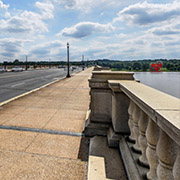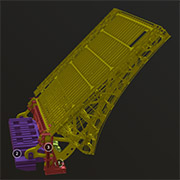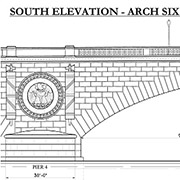Arlington Memorial Bridge
George Washington Memorial Parkway
Between Washington, DC, and Arlington, VA
Between Washington, DC, and Arlington, VA
The Arlington Memorial Bridge connects the National Mall in Washington, DC, to Arlington National Cemetery in Arlington, Virginia. It serves as the western link in a chain of monuments that starts with the U.S. Capitol Building. The bridge spans the Potomac River and was intended to join the North and South both physically and symbolically. It provides a connection between the Lincoln Memorial and Arlington House (Robert E. Lee Memorial) that is emblematic of post-Civil War reunification. The bridge's neoclassical style complements monumental buildings in Washington, DC, such as the Capitol, White House, Washington Monument, Lincoln Memorial, and Jefferson Memorial. William Mitchell Kendall designed the bridge while employed by McKim, Mead and White, a prominent architecture firm based in New York City. Joseph P. Strauss designed the Chicago-type bascule span to complement the bridge's granite-faced masonry spans. When the bridge was completed in 1932, it was the largest Chicago-type bascule span. Unlike most such bridges, its novel design located all the structural elements and mechanical equipment completely below deck so they did not detract from the bridge's monumental aesthetics.
The Historic American Engineering Record (HAER) is part of NPS's Heritage Documentation Programs (HDP). HAER staff members produced a historical report and large-format photographs of Arlington Memorial Bridge in 1986-88. A second phase of documentation, conducted in 2013-14, brought the historical report up to date and added measured drawings of the bridge and more large-format photographs. The 2013-14 project was conducted under the general direction of Richard O'Connor (HDP chief). J. Lawrence Lee (HAER engineering historian) supervised the project. The recording team was Brianna Kraft, Julia Rine, Ashley Walker, Jeremy Mauro, and Pavel Gorokhov (HAER architectural interns). Dana Lockett, Paul Davidson, and Jason McNatt (HDP architects) performed LIDAR scanning. Jet Lowe and Todd Croteau (HAER photographer and architect, respectively) produced the large-format photographs. Ashley Walker and Jeremy Mauro created a 3D model of the bascule span. Jeremy Mauro animated the model using 3dsMax. The project was sponsored by the George Washington Memorial Parkway (GWMP), National Capital Region, National Park Service; and was funded by the FHWA.
The online virtual tour, updated 3D model, and story map is the latest phase of the Arlington Memorial Bridge documentation sponsored by GWMP, HDP, and NPS's Cultural Resources GIS (CRGIS) Facility. The virtual tour, updated 3D model, and story map were created in 2018-19. They provide the an interactive way to learn about and explore the structural engineering and history of the Arlington Memorial Bridge, as well as the bridge rehabilitation project that NPS began in 2018. The virtual tour and updated 3D model were produced by Dana Lockett (HAER architect). The story map was produced by James Stein (CRGIS professional).
For information about the current status of the rehabilitation project, visit the George Washington Memorial Parkway website.
Click images below to explore content.












